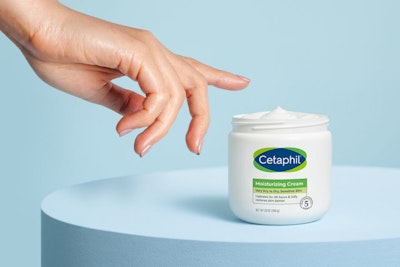Cetaphil
Cleansers and moisturizers for sensitive skin

Cetaphil's Sustainability Rating
Poor
Ingredients
Cetaphil has made a few brand-level ingredient commitments to lower its environmental impact, including by avoiding parabens. Its parent company, Galderma, reports having a Clean Beauty Charter of ingredient commitments, but this doesn't appear to be publicly available. Cetaphil still uses many ingredients that pose a significant threat to the climate, including petrochemical-based ingredients, and uncertified palm oil or palm oil-derived ingredients. Cetaphil doesn't report having any product or company-level certifications.
Containers & Packaging
Cetaphil hasn't made any efforts to concentrate its products or minimize its containers, which increases shipping emissions and packaging volumes. It doesn't report on its materials at a brand-level, and appears to use exclusively virgin plastic. Its parent company, Galderma only commits to considering recycled plastic content in the future, but it has done some work to shift to mono-materials to increase the recyclability of its plastic containers.
Energy & Water Use
Cetaphil's parent company, Galderma, shares information on its energy strategy. It uses 100% renewable energy in its manufacturing, but doesn't share information about its corporate office energy use. It also doesn't share targets for expanding its use of renewable energy or provide information on its energy efficiency programs Galderma implements water efficiency measures in its manufacturing, including water recycling and reducing water withdrawal intensity. Cetaphil has a global production span, which is standard for the industry.
Refill & Reuse
Cetaphil doesn't utilize any alternative models or methods to avert waste. It offers bulk sizes for some products, which may help reduce packaging waste.
Slow Cleaning
Cetaphil doesn't frequently release seasonal or new products, which helps prevent production of excess inventory. Its parent company has achieved zero waste to landfill at multiple manufacturing facilities.
Marketing
Commons is still evaluating this brand's marketing emails.
Transparency & Reporting
Cetaphil has a sustainability page with high-level details on its climate strategy, but this page is hard to find on its US website. Its parent company, Galderma, publishes a detailed annual report with a clear, impact-driven strategy and progress reporting. Its last annual report was published in 2023. Cetaphil shares a complete list of ingredients used in its products, on a per product basis.
Emissions Tracking
Cetaphil's parent company, Galderma, internally measures and publicly reports its company-level emissions It includes a breakdown by scope, but doesn't identify its top driver of emissions. The last reporting period was 2023. In its most recent update, its estimated emissions footprint was 345,200 tons CO2e.
Targets & Offsets
Cetaphil's parent company, Galderma, has general emissions reduction targets for the medium-term (5-10 years). Its calculations are somewhat unclear and it hasn't reported on its progress from any baseline within the past year. Commons couldn't find evidence that Galderma currently offsets any emissions.
Supply Chain & Labor
Cetaphil's parent company, Galderma, publishes information about its supply chain partners, disclosing the geographic locations of its manufacturing facilities. It publicly shares a supplier code of conduct, which prohibits forced labor and child labor. Its code of conduct doesn't disallow unauthorized subcontracting, ensure the right to collective bargaining, ensure a living wage, or establish grievance mechanisms. Galderma has a stated policy of regularly auditing its supply chain partners, which can mitigate human and environmental risks.
Advocacy
Commons wasn't able to find evidence of any trade association memberships or any relevant policy for this brand. Cetaphil's parent company, Galderma, isn't a member of any key advocacy organizations that are blocking climate policy, but it also isn't a member of advocacy organizations advancing climate policy. It doesn't employ any state lobbyists and didn't donate more than $100k to climate-obstructive candidates or PACs from 2018-2024.
Cetaphil has a Poor rating due to an overall lack of sustainability efforts and disclosures. We expect more initiatives and transparency from a brand of its size.
Cetaphil and its parent company do not make many publicly-available ingredient commitments, and Cetaphil uses many ingredients that pose a significant threat to the climate, including petrochemical-based ingredients, and uncertified palm oil or palm oil-derived ingredients. It doesn't utilize any alternative models or packaging minimization strategies to reduce its waste and emissions footprint, and it uses primarily plastic packaging of a virgin or undisclosed source, which contributes greatly to waste production and excess energy use.
Cetaphil's parent company reports on its renewable energy strategy and emissions measurement and reduction efforts.
Cetaphil is owned by Galderma.
Our ratings are based on a scale from 1 (harmful) to 5 (best). How we rate →
https://www.galderma.com/sites/default/files/2025-03/galderma_annual_report_2024.pdf
https://www.cetaphil.com/us/why-cetaphil/environment-and-sustainability.html
https://www.galderma.com/sites/default/files/2024-06/Galderma_ESG_Update_23_HD.pdf
https://www.cetaphil-me.com/en/why-cetaphil/environment-and-sustainability.html
https://www.galderma.com/us/manufacturing
https://suppliers.galderma.com/sites/default/files/2021-09/Galderma%20Supplier%20Code_2021.pdf
https://fminus.org/lobbyists/
https://www.fec.gov/data/browse-data/
Get Rewards
Earn for sustainable purchases
Commons rewards you for sustainable purchases from all our Top Rated brands, plus thousands of everyday purchases — from thrift stores to public transit.
Learn more about rewards ->







